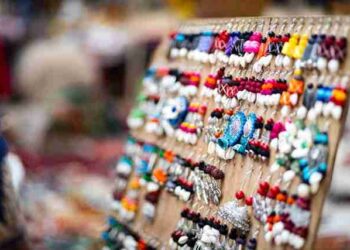Rajasthan, known for its royal history, desert landscapes, and vibrant culture, is a treasure trove of handicrafts that reflect the state’s rich heritage and artistic brilliance. Rajasthani handicrafts have enchanted people for centuries with their intricate designs, vibrant colors, and unique craftsmanship. From textiles and pottery to jewelry and woodwork, the handicrafts of Rajasthan are a perfect amalgamation of beauty, tradition, and functionality.
Historical Background of Rajasthani Handicrafts
The tradition of handicrafts in Rajasthan goes back to the time of the Rajput kings, who were great patrons of the arts. Skilled artisans were encouraged by the royal families, leading to the development of exquisite craftsmanship that catered to the needs of the royals and temples. Over the centuries, these crafts were passed down through generations and have become an integral part of Rajasthan’s cultural identity.
Famous Rajasthani Handicrafts
- Textile Craft Rajasthan is synonymous with vibrant and colorful textiles that are a key part of the state’s craft tradition. Textile crafts in Rajasthan reflect the state’s colorful culture and traditional dyeing techniques.
- Bandhani (Tie and Dye): This centuries-old technique involves tying small portions of fabric with threads before dyeing them in bright hues. Bandhani is used in sarees, turbans, and dupattas, with patterns that range from simple dots to intricate designs.
- Leheriya: Another form of tie-dye, Leheriya creates diagonal, wavy patterns that resemble ripples of water. This technique is predominantly used to make sarees and turbans.
- Block Printing: Rajasthan’s block printing, particularly from Jaipur and Sanganer, is world-famous. Hand-carved wooden blocks are dipped in natural dyes and stamped onto fabric to create stunning floral and geometric patterns. Bagru prints are another famous style of block printing.
- Gota Patti: This is a form of applique work using gold and silver ribbons to create intricate patterns on sarees and lehengas, especially worn during weddings and festivals.
- Jewelry Craft Rajasthan’s jewelry is known for its grandeur, with styles that showcase intricate craftsmanship and the use of precious metals and stones.
- Kundan and Polki Jewelry: These are the most traditional forms of Rajasthani jewelry. Kundan involves setting gemstones in gold foil, while Polki is crafted using uncut diamonds. Both styles are known for their opulence and are often worn during weddings.
- Meenakari Jewelry: This is the art of enameling metals with vibrant colors, which originated in Jaipur. Meenakari work is used to embellish gold and silver jewelry, creating vivid, detailed designs.
- Lac Jewelry: Lac, a resinous substance, is molded into beautiful jewelry items such as bangles, earrings, and necklaces. These colorful, handcrafted pieces are often decorated with beads and mirrors.
- Silver Jewelry: Rajasthan is also famous for its silver jewelry, which includes elaborate anklets, necklaces, and rings. Regions like Udaipur and Jaisalmer are renowned for their silver crafting.
- Pottery and Ceramics Rajasthan’s pottery is a unique blend of beauty and utility, reflecting both traditional and contemporary influences.
- Blue Pottery: Originating from Jaipur, blue pottery is known for its distinctive blue glaze and intricate patterns. The pottery is made from quartz instead of clay, making it unique in texture. The designs are hand-painted, often featuring floral and animal motifs.
- Terracotta Pottery: In regions like Molela, artisans craft terracotta figures and idols. These clay creations are baked and used as decorative and religious items.
- Black Pottery: Found in the villages of Rajasthan, this pottery is made by mixing clay with various minerals and baked in a kiln to give it a rich black sheen.
- Wooden Handicrafts Rajasthan’s wooden handicrafts are known for their intricacy and attention to detail, whether in furniture, decor, or toys.
- Wooden Furniture: Rajasthan produces beautiful handcrafted furniture, often adorned with carvings, inlay work, and brass detailing. Jodhpur, in particular, is known for its antique-style wooden furniture, including beds, cabinets, and chairs.
- Wooden Toys: Udaipur and other regions in Rajasthan are famous for their hand-painted wooden toys, which depict animals, birds, and traditional Rajasthani figures. The toys are bright, eco-friendly, and reflect the state’s folklore.
- Kathputlis (Puppets): Rajasthani puppetry, or Kathputli, is a traditional form of entertainment. These puppets are made of carved wood and adorned with colorful clothes and paint. They are a significant part of Rajasthani folk performances.
- Metal Crafts Rajasthan excels in metalwork, with artisans creating everything from functional items to elaborate decor.
- Brassware: The brass artisans of Rajasthan produce beautiful home decor items, utensils, and religious artifacts. The designs are often intricately engraved or embossed, reflecting traditional Rajasthani motifs.
- Dhokra Art: Although more commonly associated with tribal regions in India, Dhokra art, which involves lost-wax casting of metals like brass and bronze, is also practiced by tribal communities in Rajasthan.
- Iron Craft: Jodhpur is known for its iron crafts, with artisans creating items like lamps, lanterns, and furniture using wrought iron. These items often feature traditional Rajasthani designs.
- Leather Craft Leatherwork is an ancient craft in Rajasthan, with artisans creating a wide range of products from camel leather.
- Mojari (Juttis): These are traditional Rajasthani footwear made from camel leather and adorned with embroidery, beads, and mirrors. Mojari shoes are popular for their comfort and vibrant designs.
- Leather Bags and Accessories: Handcrafted leather bags, wallets, and belts made from camel leather are commonly found in the markets of Rajasthan. The leather is often hand-painted or embroidered with traditional motifs.
- Carpet and Dhurrie Weaving Rajasthan’s carpets and dhurries (flat-woven rugs) are famous for their craftsmanship and vibrant colors. Jaipur, Ajmer, and Bikaner are hubs for this craft. These handwoven rugs often feature geometric or floral designs, and the wool or cotton used is dyed in traditional natural colors.
- Stone Carving and Marble Work Rajasthan’s abundance of marble and sandstone has given rise to a thriving stone-carving industry.
- Marble Sculptures: Rajasthan, particularly the city of Makrana, is known for its high-quality marble used in creating religious idols, sculptures, and decorative items. The Taj Mahal, one of the Seven Wonders of the World, was built with marble from Makrana.
- Marble Inlay Work: This involves embedding semi-precious stones into marble to create intricate patterns, often seen in tabletops, coasters, and other decorative items.
- Sandstone Carving: The temples and palaces of Rajasthan are adorned with detailed sandstone carvings. Artisans today continue to create sculptures, pillars, and home decor using sandstone.
- Paintings Rajasthani paintings are rich in color and detail, reflecting the state’s history, mythology, and cultural life.
- Miniature Paintings: Rajasthan is famous for its miniature paintings, characterized by fine brushwork and vivid colors. These paintings often depict scenes from the Ramayana, Mahabharata, and royal life. Kishangarh, Udaipur, and Jaipur are centers of miniature painting.
- Phad Paintings: Phad paintings are large scrolls that depict the stories of local deities like Pabuji and Devnarayan. These paintings are vibrant and detailed, often used in religious storytelling and temple rituals.
- Pichwai Paintings: These are intricate paintings created on cloth, often used to decorate temples. They depict scenes from the life of Lord Krishna and are typically made in the Nathdwara region.
Importance of Rajasthani Handicrafts in Modern Times
Rajasthani handicrafts are not just objects of beauty but also a source of livelihood for millions of artisans in the state. These crafts are highly sought after by tourists and have a global market due to their uniqueness and cultural richness. Government initiatives and platforms like Rajasthan Haat and various online marketplaces have helped promote these crafts to a worldwide audience. The fusion of traditional techniques with modern designs ensures that Rajasthani handicrafts remain relevant in contemporary times.
Conclusion
Rajasthani handicrafts online are a testament to the state’s vibrant culture, historical legacy, and artistic excellence. From colorful textiles and jewelry to intricate woodwork and pottery, each craft tells a story of Rajasthan’s rich tradition and the skill of its artisans. Today, these handicrafts continue to be a significant part of the state’s economy and cultural identity, admired by people from all over the world.














